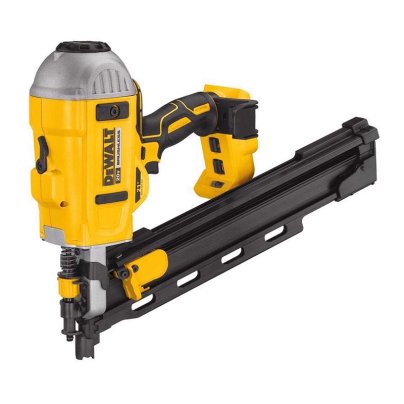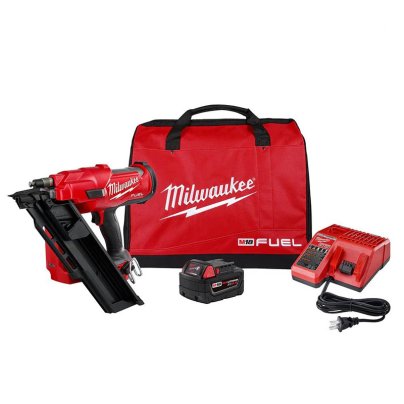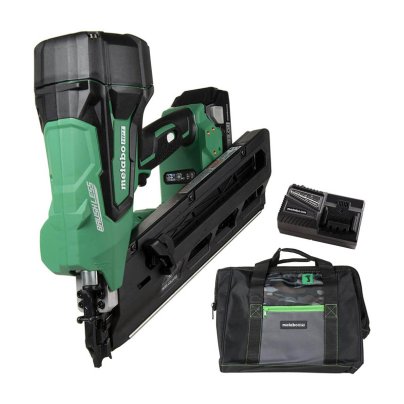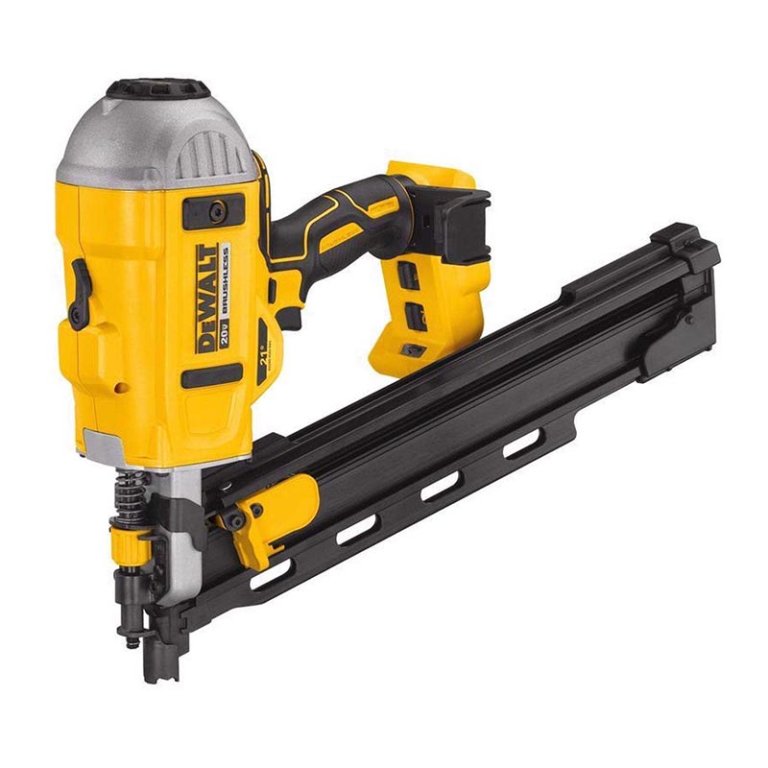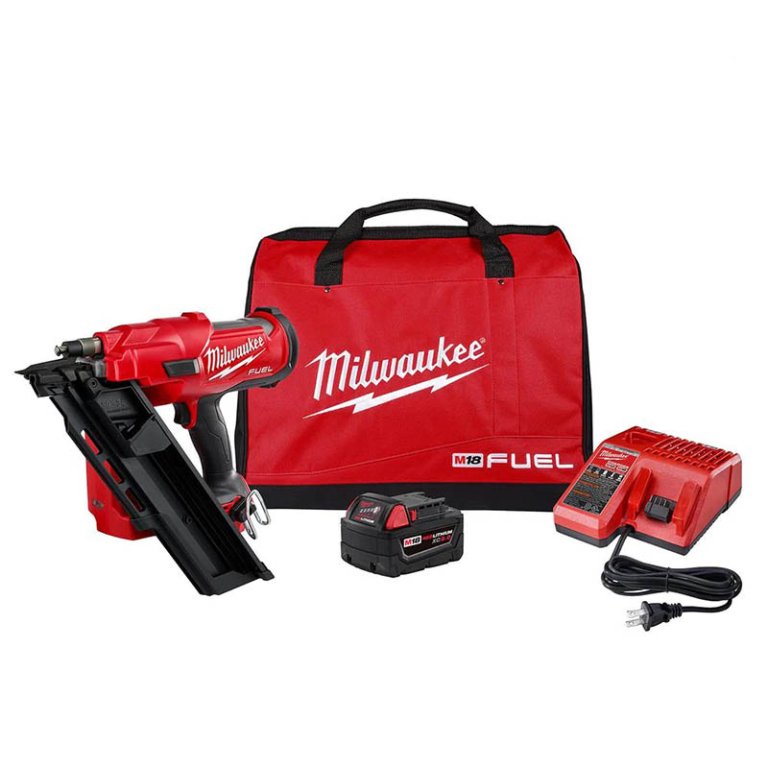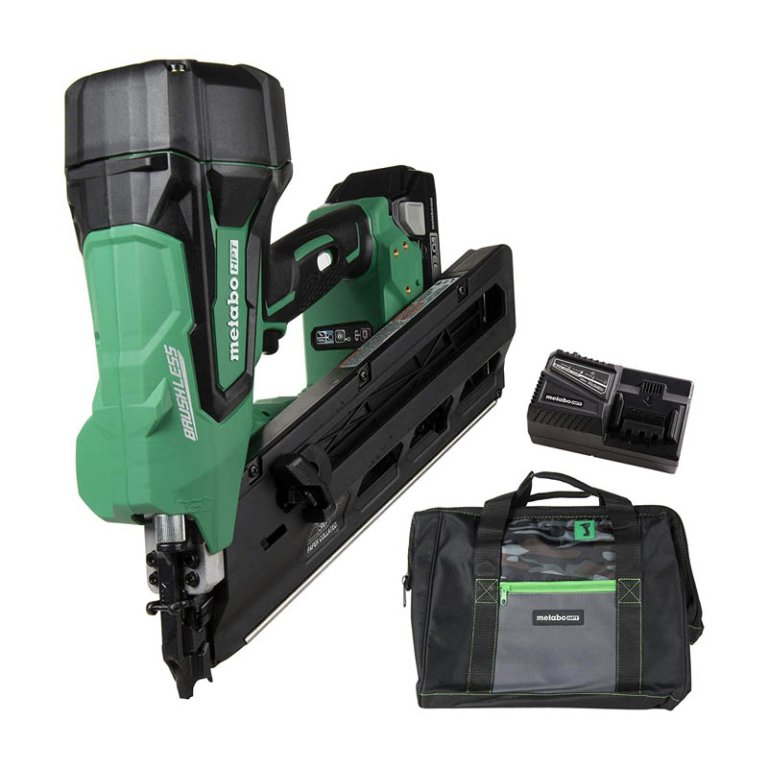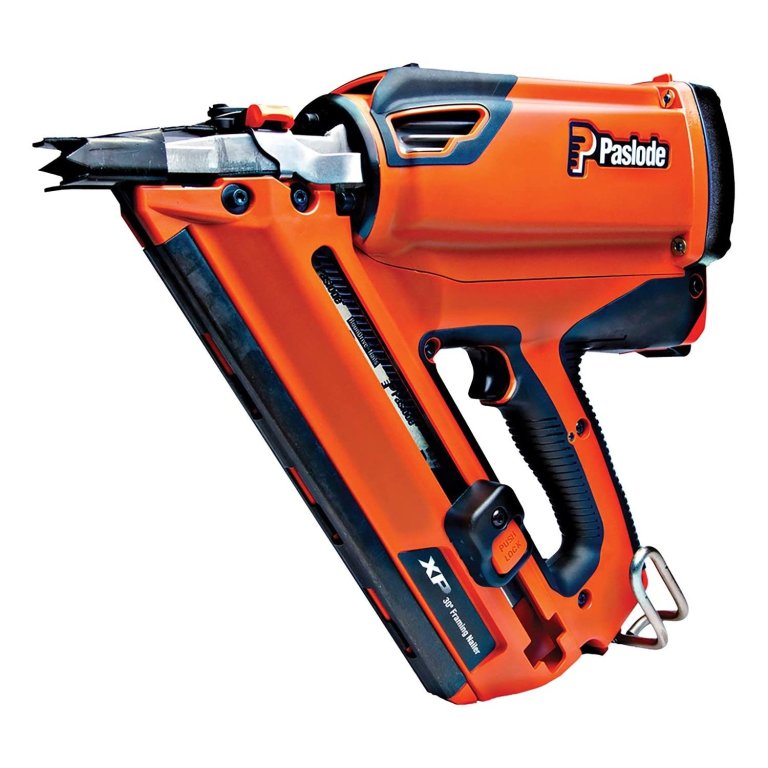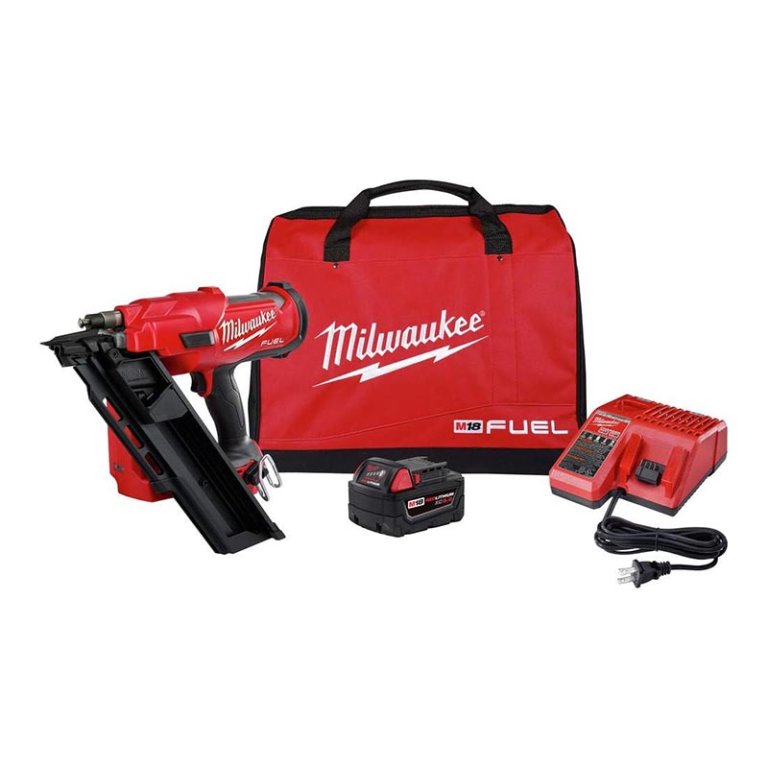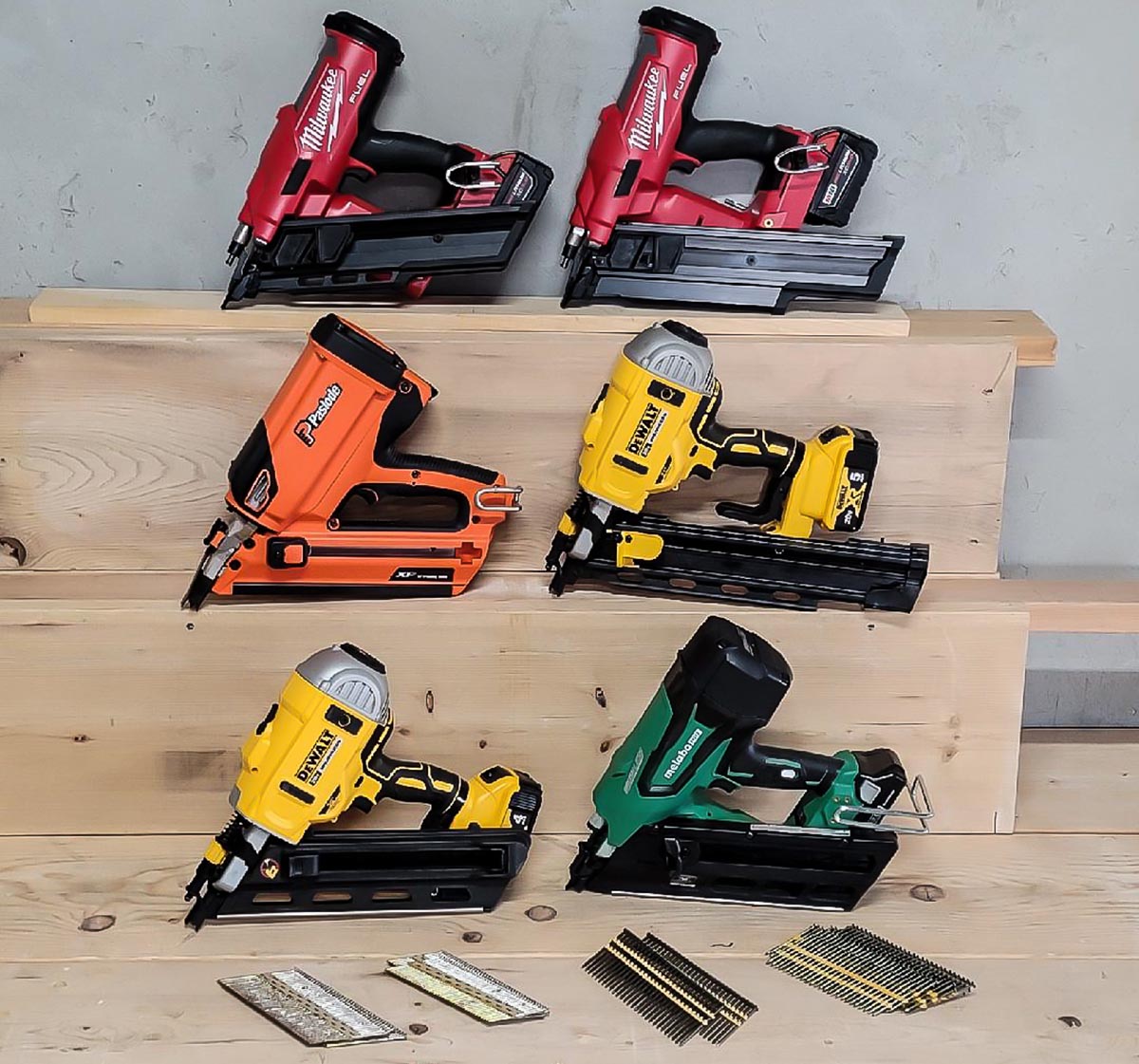
We may earn revenue from the products available on this page and participate in affiliate programs. Learn More ›
Driving a nail with a single hammer stroke is almost a skill of the past—but with today’s power nailers, it’s no longer necessary. We tested today’s top-selling cordless framing nailers and thoroughly researched dozens more to bring you the best models for a range of budgets and projects.
These portable power tools are relatively lightweight and powerful enough for nailing dense framing lumber.
Keep reading if you’re considering adding one of these convenient devices to your tool kit. This guide details the information you need to know when shopping for the best cordless framing nailer and delivers the pros and cons of the following models that earned a spot on our lineup.
- BEST OVERALL: DeWalt 20V MAX 21° Cordless Framing Nailer
- RUNNER-UP: Milwaukee 2744-21 M18 Fuel 21° Framing Nailer Kit
- BEST BANG FOR THE BUCK: Metabo HPT 18V 30° Paper Strip Framing Nailer Kit
- UPGRADE PICK: DeWalt 20V MAX XR Cordless 30° Framing Nailer Kit
- BEST GAS: Paslode Cordless XP 30° Framing Nailer
- BEST 30-DEGREE: Milwaukee 2745-21 M18 Fuel 30° Framing Nailer Kit
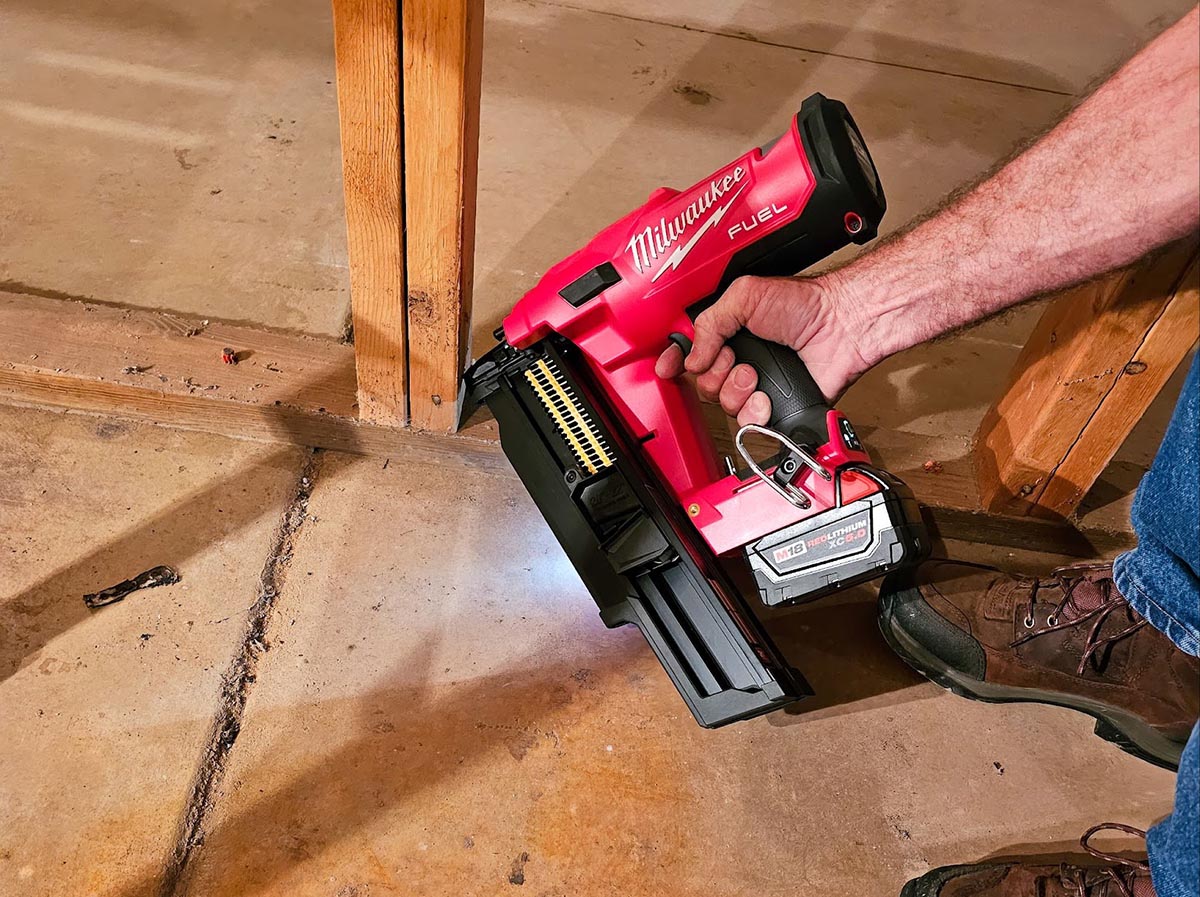
How We Tested the Best Cordless Framing Nailers
Before choosing cordless framing nailers for testing in our workshops and jobsites, we carefully researched several dozen models—analyzing customer feedback, overall satisfaction, and beneficial features such as brushed motors and stall releases. We then narrowed down our picks to the highest-rated products on the market.
In actual testing, we evaluated the nailers’ performance in common framing scenarios—attaching sheathing and subfloor and connecting wall studs to floor and ceiling plates to determine how the tools would perform in real-world scenarios. We also tested each tool by firing nails into dense hardwood to see how much nailing power each could produce.
We awarded points based on a rubric. The better a nailer performed, the more points we gave it for each specific task. We also awarded points for special features, such as rafter hooks and easy-to-use depth-adjustment mechanisms.
We compared their prices, power, accessories, and overall value to ensure we suggested only the best cordless nail guns on the market. After testing and evaluation, we averaged the points and used them to determine the best uses for each product that made the cut.
Our Top Picks
Framing nailers are all about convenience and making the job as easy as possible, but choosing one can be confusing. To help simplify the shopping process, refer to the following list of some of the best cordless framing nailers on the market, complete with pros and cons for each tool.
Best Overall
DeWalt 20V MAX 21° Cordless Framing Nailer
What We Like
- Adjustable speed controls for added versatility and user-friendliness
- Tool-free depth adjustment provides added safety and ease of use
- Heavy-duty contractor bag for storing kit for portability and transporting
- Adjustable rafter hook is suitable for the worksite as well as the workshop
What We Don’t Like
- Experienced a slight recovery drag after 5 to 7 rapid-fire shots in bump mode
Product Specs
- Power source: 20-volt (V) lithium-ion battery
- Angle: 21 degrees
- Maximum nail length: 3.25 inches
- Additional features: Rafter hook, easy depth adjustment, stall release
This Bob Vila Approved product carries our brand’s highest level of recommendation.

Bob Vila Approved recognizes the household and DIY products that impressed us most in our real-world testing and that exemplify core values of the Bob Vila brand, including craftsmanship, innovation, and value for the dollar. Winners of this designation come recommended by our professional review team and are personally approved by Bob Vila.
In our tests, the DeWalt 21-degree cordless framing nailer turned out to be a real workhorse, and its high performance level earned it the top spot. Weighing in at 8.5 pounds, this DeWalt tool is a study in both portability and power. While it’s lighter than some models we tested, it’s still a tad heavier than most pneumatic and gas-powered models. However, we found it well balanced and easy to handle.
The depth-adjustment feature was essential as we switched from dimensional lumber to hardwood since shooting nails into each requires a different degree of force.
The DeWalt’s 21-degree angled nose made it easy to use in tight spots, including attaching vertical wall studs to ceiling and floor plates at an angle (toenailing).
One minor drawback we noticed is the nailer’s slightly slower recovery time in bump mode. After five to seven rapid-fire shots, the DeWalt slowed down a tad. This could be a consideration for professionals looking for lightning-fast nailing for tasks like attaching sheathing. For the average DIYer, it shouldn’t pose any noticeable issues—simply pausing a couple of seconds was all it took for the nailer to keep up.
Ergonomics matter when working with a tool for extended periods, and the DeWalt doesn’t disappoint. Its comfortable grip made it easy to grasp without slipping or causing hand fatigue. Additionally, it comes equipped with a handy rafter hook for hanging the nailer on a rafter when working at heights. Anyone who’s accidentally dropped a pricey power tool while framing a roof will appreciate a rafter hook.
The nailer includes a stall release lever, which helps reset the driver blade when a nail becomes stuck in both the tool and the wood, but we did not experience any stalls. We didn’t have any nail jams either, but we would have appreciated a quick jam release in the event one occurred. This nailer requires removing the front plate, which is held on with two screws, and then pulling out a jammed nail with pliers.
The DeWalt cordless framing nailer boasts a high-strength aluminum magazine with an easy-to-operate pusher latch. It accepts a range of 21-degree plastic collated fasteners up to 3.25 inches in length.
We were impressed with the DeWalt and found it to be an excellent choice for framing and subfloor applications. It’s suitable for both professionals and DIYers tackling a range of projects, from residential framing to deck building and sheathing, with its only notable limitation being a slightly slower recovery time during rapid firing.
Get the DeWalt 21-degree cordless framing nailer at Ace Hardware or The Home Depot.
Runner-Up
Milwaukee 2744-21 M18 Fuel 21° Framing Nailer Kit
What We Like
- Fires up to 3 nails per second; suitable for getting jobs done quickly
- Tool-free depth-adjustment feature is safe and easy to use
- Sequential and bump-firing modes allow for versatility and user-friendliness
- Fires up to 700 nails on a single charge; perfect for DIY or professional use
What We Don’t Like
- A bit heavier (at 11 pounds) than other nailers; may lead to fatigue with extended use
Product Specs
- Power source: 18V lithium-ion battery
- Angle: 21 degrees
- Maximum nail length: 3.5 inches
- Additional features: Belt and rafter hooks, toolless depth adjustment
The Milwaukee M18 Fuel 21-degree cordless framing nailer is a standout performer in its own right. In our hands-on testing, it demonstrated exceptional qualities and noteworthy features, making it a top choice for carpenters and remodelers seeking a reliable cordless framing nailer.
One of the key highlights of the Milwaukee M18 Fuel nailer was its outstanding performance. This tool effortlessly drives full round-head nails into dense engineered lumber, making it well suited for demanding framing applications. Its nitrogen spring mechanism sets it apart and gives it a pneumatic boost. In practical terms, this translates to remarkable speed and efficiency. During rapid-fire mode, we fired more than 10 nails in rapid succession without any noticeable lag.
We didn’t experience any stalls, but we did have two jams, both occurring while working with hardwood using bump-fire mode. Although it lacks a quick jam-release feature, the nailer’s infrequent jamming means you can work confidently, knowing interruptions will be minimal.
Being cordless is particularly valuable for projects in remote locations or areas without access to electrical outlets. It eliminates the need for gas cartridges and the inconvenience of managing extension cords.
The Milwaukee M18 Fuel 21-degree cordless framing nailer comes as a comprehensive kit, including a rechargeable battery, a charger, and a contractor bag. This all-in-one package adds to the tool’s convenience and value—it’s ready to use right out of the bag after charging the battery.
The Milwaukee nailer weighs approximately 11 pounds. While it’s heavier than some competitors, its ergonomic design helps with comfort during prolonged use. Ultimately, the choice between this nailer and others may come down to individual preferences and the specific demands of the job.
Get the Milwaukee 21-degree cordless framing nailer at The Home Depot, Ace Hardware, or Acme Tools.
Best Bang for the Buck
Metabo HPT 18V 30° Paper Strip Framing Nailer Kit
What We Like
- Full kit in 1 purchase; comes with an 18V battery, a charger, a rafter hook, safety glasses, and a heavy-duty contractor bag
- Switching between sequential and bump firing is straightforward; easy to use
- Toolless depth-adjustment feature for added convenience and user-friendliness
- Lithium-ion battery provides more power for long-term use per charge
What We Don’t Like
- Battery might be slightly too small for production framing; may not suit some users’ preferences
Product Specs
- Power source: 18V lithium-ion battery
- Angle: 30 degrees
- Maximum nail length: 3.5 inches
- Additional features: Rafter hook, toolless depth adjustment
The Metabo HPT cordless framing nailer is an economical pick that offers an affordable solution without compromising performance. We found it a dependable choice for those on a budget seeking a cordless framing nailer.
However, our initial encounter with the tool was less than ideal, as the first unit we received was a dud—we spent nearly an hour on the phone with customer service troubleshooting it. It simply could not generate the necessary power to sink a single nail. However, the manufacturer promptly replaced it, and the replacement model performed admirably. We’re now fans of Metabo HPT’s customer service.
This Metabo HPT nailer features a 30-degree magazine angle, which is beneficial when working in tight spots where a nonangled nailer would be challenging to maneuver.
In bump mode, the nailer fired nails rapidly, but there was a slight lag when we reached the fourth or fifth nail in rapid succession. This suggests it might not be ideal for professionals requiring lightning-fast nailing when attaching sheathing or subfloor. However, this performance difference is negligible for DIYers or those with smaller framing projects.
One of the standout features is the ergonomic grip, which fits comfortably in the hand and provides a secure hold, preventing slipping during operation. While it weighs in at 9.9 pounds, lighter than some competitors, it still has substantial heft, which could lead to fatigue, especially if working overhead for extended periods.
The depth-adjustment feature on the Metabo HPT nailer required some tweaking to achieve the desired setting when transitioning between dimensional lumber and hardwood boards. While not as seamless as some premium models, it does the job effectively.
The nailer comes with a 3 amp-hour (Ah) battery, which performed well but started to lose a charge after an hour of continuous use. If you plan on using it for longer durations, it’s advisable to purchase an additional backup battery and keep it charged for easy swapping.
The Metabo HPT nailer does not include a stall release lever, but stall risk can be reduced by replacing the battery before it loses power, as stalls are most likely to occur when the battery starts to lag.
The nailer accepts 30-degree clipped or offset round-head nails ranging from 2 inches to 3½ inches in length. While it may not match the performance of premium models, it offers reliability and versatility for various framing tasks. Its 30-degree magazine angle and ergonomic grip enhance its appeal, making it a practical option for DIYers and budget-conscious professionals.
Get the Metabo HPT cordless framing nailer at Amazon or Menards.
Upgrade Pick
DeWalt 20V MAX XR Cordless 30° Framing Nailer Kit
What We Like
- Powerful nailer—fires nails reliably in both single-fire and bump-fire modes
- Depth adjustment is easy to use and precise; no need to tweak and test
- Dry fire lockout keeps the nailer from shooting when nails run out
- Lightweight (7.8 pounds) and ergonomic, making it well suited for extended use
- Well balanced and powerful enough to be considered a professional nailer
What We Don’t Like
- Pricier compared to some alternatives, which may deter budget-conscious users
Product Specs
- Power source: 20V lithium-ion battery
- Angle: 30 degrees
- Maximum nail length: 3.5 inches
- Additional features: Rafter hook, toolless depth adjustment, battery, charger
The DeWalt 20V MAX framing nailer, featuring a 30-degree angle, earned its Upgrade Pick award by delivering exceptional power and precision, even though it comes at a slightly higher price point. In our tests, this nailer was a top performer, showcasing several impressive features that set it apart in the world of cordless framing nailers.
The DeWalt 20V MAX framing nailer stands out for its sheer power. Whether in single-fire or rapid-fire modes, it consistently fired nails without a hint of lag, even after running a dozen nails through it in bump-fire mode. This performance is a game changer for professionals seeking a cordless framer that can keep up with demanding tasks.
The depth-adjustment feature is spot on, eliminating the need for constant fiddling. It was easy to gauge how much adjustment was needed to fine-tune the force for nailing dimensional lumber and hardwood.
We really liked the dry fire lockout feature. It prevented the tool from firing when the nails ran out, sparing us from the frustration of thinking the nailer was still firing when it was not.
While this DeWalt nailer doesn’t have a quick jam-release feature, removing a jammed nail is straightforward thanks to easy access to the nosepiece. Fortunately, during our testing, the tool performed without any jams.
Weighing in at just under 8 pounds, it’s one of the lighter options we tested, and its nonslip ergonomic grip made it comfortable to use, even during extended testing.
This cordless framing nailer is designed for complete framing jobs, capable of driving nails from 2 inches to 3.5 inches in length. Its brushless motor is engineered for increased power and drive quality. Additional features include a stall release lever and an adjustable rafter hook.
While it may come at a slightly higher price point, its performance, ergonomic design, and user-friendly features make it a worthwhile investment for residential framing, setting trusses, fence building, deck building, and sheathing. It’s an all-around top pick for pros.
Get the Dewalt 30-degree cordless framing nailer at Amazon, Ace Hardware, or The Home Depot.
Best Gas
Paslode Cordless XP 30° Framing Nailer
What We Like
- Fires up to 9,000 nails per charge; gets the job done quickly
- Powerful enough for dense framing materials; perfect for professional or DIY use
- Compact and lightweight design is suitable for the workshop or transporting
- Lithium-ion battery provides ample battery power for long-term use per charge
What We Don’t Like
- Fuel cells aren’t rechargeable; may lose power over time and with heavy-duty use
- Does not feature a rapid-fire (bump) mode, but sequential mode is quick
Product Specs
- Power source: Gas and 7V lithium-ion battery
- Angle: 30 degrees
- Maximum nail length: 3.25 inches
- Additional features: Tool-free depth adjustment, utility hook
The Paslode cordless framing nailer left a lasting impression on us—all good. Paslode is renowned for its high-quality nailers, and this model lives up to the brand’s reputation with an impressive blend of power, consistency, and adaptability.
What immediately caught our attention was the nailer’s unique ability to harness two power sources: a battery and gas cartridges. This dual-power feature provides unparalleled flexibility and extends the nailer’s runtime significantly—it offers the best of both worlds for someone who frequently tackles demanding framing tasks.
The Paslode handled various framing tasks effortlessly, including stair-tread installation, subfloor work, and wall framing. And we were able to quickly and easily adjust the nailing depth to suit the different materials we were working with.
Weighing in at a mere 7.2 pounds, this nailer is remarkably lightweight. We found it well balanced with an ergonomic grip that reduced the risk of hand fatigue after prolonged use.
While the nailer will work with various nail brands, it excels when paired with Paslode-brand nails. Loading gas cartridges into the nailer is straightforward, and the cartridges, while sold separately, are readily available at most home improvement stores. Each cartridge boasts an impressive capacity, delivering up to 1,200 shots before requiring replacement. It’s worth noting that the gas cartridges, while powerful, are not rechargeable the way a battery is. When empty, the cartridge needs to be properly recycled or disposed of and then replaced. In terms of battery life, the nailer can drive up to 9,000 nails on a single battery charge, ensuring that even professionals won’t run out of battery power during a demanding day of framing. In our testing, which lasted nearly 2 hours, we didn’t notice any drop in power.
The nailer’s 30-degree angled design makes it ideal for working in tight spots. Additionally, a belt hook enhances its portability, allowing it to hang conveniently on a tool belt for quick access during tasks.
The only downside we noticed—and it’s not a deal breaker—is that the nailer operates solely in single-fire (sequential) mode. There’s no bump mode. However, the nailer’s impressive speed and consistent performance easily made up for that lack in our tests.
Get the Paslode cordless framing nailer at Lowe’s or The Home Depot.
Best 30-Degree
Milwaukee 2745-21 M18 Fuel 30° Framing Nailer Kit
What We Like
- Fires up to 700 nails on 1 charge; gets the job done quickly
- Comes with belt and rafter hooks for use on the jobsite or workshop
- Tool-free depth adjustments are safe and easy to use
- Lithium-ion battery provides ample battery power for long-term use per charge
What We Don’t Like
- It’s a bit heavy at 11 pounds; may be tricky to maneuver while on the jobsite
Product Specs
- Power source: 18V lithium-ion battery
- Angle: 30 degrees
- Maximum nail length: 3.5 inches
- Additional features: Tool-free depth adjustments, belt and rafter hooks
The 30-degree framing nailer from Milwaukee impressed us with its performance and the included high-capacity 5Ah battery and charger, making it a ready-to-go option.
What stood out most about the nailer was its sheer power. It effortlessly drove nails into hardwood as quickly as it did into dimensional lumber. With the included 5Ah battery, we had full power throughout our entire testing and no lagging or need to recharge.
Weighing in at 11 pounds, this nailer is heavier than most of the other models we tested. But don’t let its weight deter you—it excels in tasks such as attaching subfloors and framing walls. Our only challenge was working overhead for prolonged periods, where the weight became slightly cumbersome. Someone with a stronger upper body might have no problem at all.
A belt hook and a rafter hook allowed us to stow the nailer securely on our tool belt or hang it on a rafter or joist without worrying about it falling and breaking.
Adjusting the nailing depth was simple, and the angled-nose design allowed us to work in tight spots efficiently. Although this nailer lacks a stall release, we never experienced a nail stall during testing, so its absence was not a significant concern. Similarly, it doesn’t have a quick jam release, but removing the nose plate and using a pair of pliers to extract a jammed nail is straightforward.
We were thoroughly impressed by the quality of this tool. In rapid-fire mode, we ran more than a dozen nails through it, and it didn’t exhibit the slightest hint of lag. The Milwaukee 30-degree framing nailer is a powerful and convenient choice for framing tasks. While it may be heavier than some competitors, its performance, adjustability, and overall quality make it an excellent tool for professionals and DIY enthusiasts.
Get the Milwaukee 30-degree cordless framing nailer at Ace Hardware or The Home Depot.
Jump to Our Top Picks
What to Consider When Choosing a Cordless Framing Nailer
Modern battery-powered framing nailers are as capable as their pneumatic brethren but without all the noise and hoses to trip over. Still, there are a few factors shoppers will want to weigh before choosing the right model for their needs. The following sections will nail down some of the most important considerations to keep in mind when selecting the best cordless framing nailer.
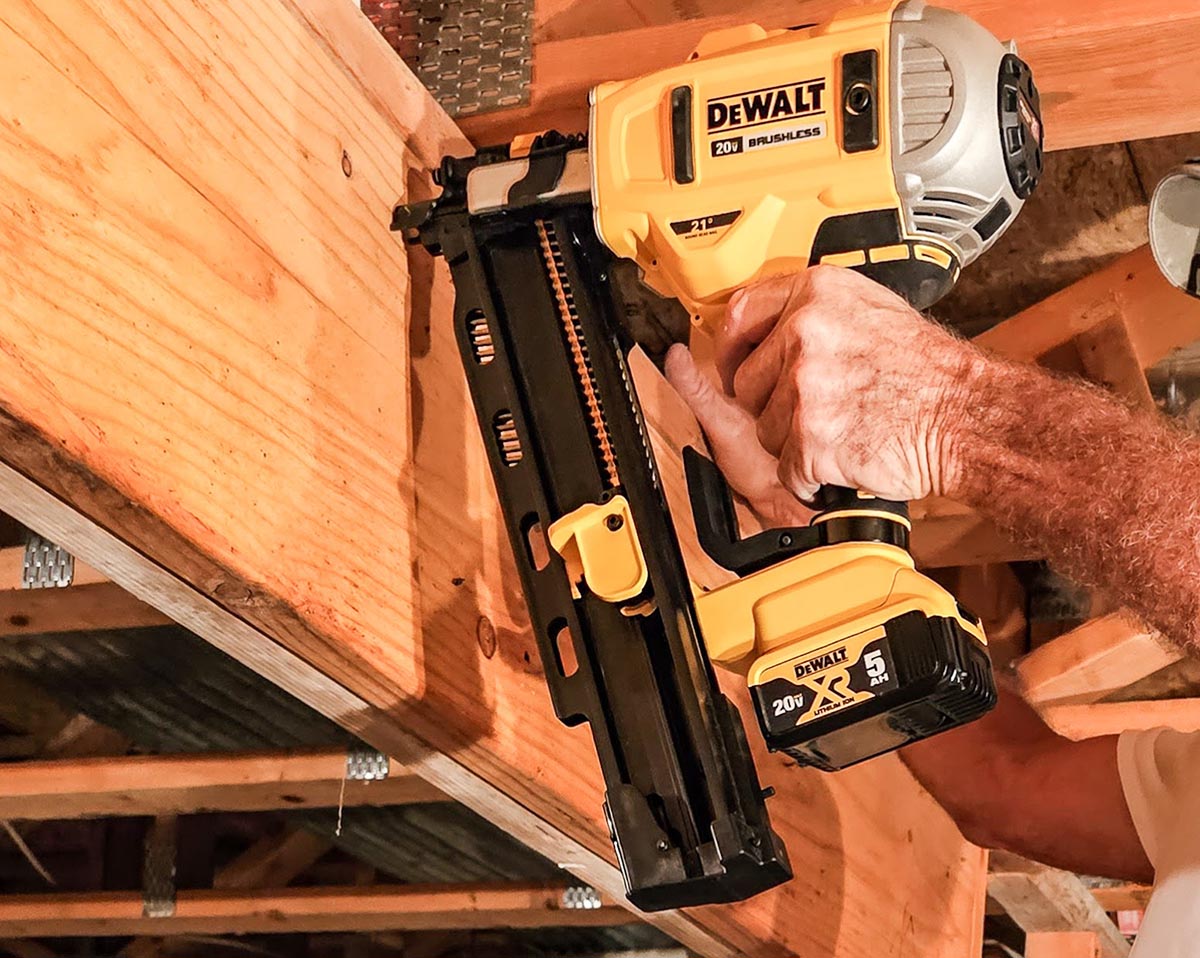
Size and Weight
One point to keep in mind is that framing nailers, whether cordless or pneumatic, are not light power tools. Given that a pneumatic framing hammer might weigh just 23 ounces, a 10-pound cordless framing nailer can feel hefty—and that’s before adding a stick of nails to the magazine. Ten pounds might not sound heavy, but it will certainly be noticeable after a long day of framing.
Also, it’s important to understand that framing nailers are not small. They’re much larger than finish nailers, and poorly designed models can be unwieldy. Finding a model that will fit comfortably between standard 16-inch studs is essential. Luckily, a cordless framing nailer doesn’t have hoses and adapters to contend with, so it’s still going to be easier to maneuver than most pneumatic nailers.
Intended Use
Cordless framing nailers are explicitly for framing or fastening structural floor, wall, and roofing materials in place. These power tools are intended to drive large, heavy nails, making them more about structure and power than finesse. Since framing nailers can often split wood and leave behind marks, keep in mind that they’re suitable for construction framing only.
Framing nailers are less ideal for roofing, as the nails they shoot will tear right through the shingles. They are also not the best bet for siding; the nails will fasten the siding too tightly to the home’s structure. These tools are also far too powerful for finish or brad nailing. For any of these applications, choose a cordless nail gun explicitly designed for these particular jobs; however, be aware that some nail guns are easier to use than others.
Brushed vs. Brushless Motor
Electric cordless framing nailers utilize an electric motor to fire nails, and those motors are available in both brushed and brushless models. Getting into the specifics of how a brushed motor and a brushless motor differ would require more engineering background than this guide is prepared to cover, but the pros and cons are straightforward.
- Brushed motors are the common old-school electric nail guns. They’re affordable and offer plenty of power to get the job done. These motors are also large and heavy and will drain a battery faster than brushless options.
- Brushless motors are the newer generation of electric nail guns. They’re even more powerful, more efficient, and more compact than brushed motors. But, as they’re newer, these models are often more expensive.
Power Source and Runtime
Cordless framing nailers feature two main types of power: gas and battery.
- The original cordless framing nailers were all gas-powered, as battery technology didn’t have the power it does today. These nailers use a consumable cartridge of combustible gas and a spark to fire a nail into a piece of lumber. Gas models are very powerful, and the cartridges last a long time (up to 1,300 nails), but they can’t be recharged like a battery-powered model.
- Battery-powered cordless framing nailers use electric motors to fire the nails, and though technology has certainly improved, they’re not as powerful as gas models. While battery models don’t last as long (300 to 700 nails), they have the added benefit of rechargeable batteries that save time and money in the long run. They’re also lower-maintenance devices.
Framing Angle and Nail Type
Cordless framing nailers operate at four different angles: 15, 21, 28, and 30 degrees, with 21- and 30-degree being the most common. The angle is the measurement between the plane of the nail and the angle of the magazine. Each of these distinct nailers also takes a specific nail type that must match the angle of the nailer gun.
- 15-degree framing nailers are upright, compact, and have drum-style cartridges that accept coiled nails. The nails also feature a fully round head, which gives them a better grip over a clipped head. Since these nailers are compact, they can fit in tight spots. However, they aren’t yet available in cordless models.
- 21-degree framing nailers have a more slanted angle than 15-degree models, which gives them better access in tight corners. These models use nails with fully round heads that come in a straight plastic-collated stack also known as a stick.
- 28-degree framing nailers use nails held together by a wire strip, and their heads are either offset or clipped to allow them to nest closely together in a stack.
- 30-degree framing nailers offer the best access in awkward, tight corners. They use sticks of clipped or offset nails held together by paper strips.
Beyond nailhead shapes, framing nails also come in different lengths. Most framing nailers can handle a range between a 2-inch length (used for sheathing buildings with plywood) and a 3.25-inch length, with some nailers accepting up to a 3.5-inch length.
Additional Features
Cordless nailers often include extra features to make them more useful, convenient, and safe. For instance, some models might provide a belt hook that slides over a tool belt, so framers can climb a ladder with both hands or manipulate a workpiece without putting the nailer on the ground.
Also, most framing nailers have lockouts that prevent a nail from firing without pressing the tip firmly against a piece of wood. Many allow you to choose between sequential (driving one nail) or bump fire, which will fire a nail each time the tip bumps against a surface as long as the trigger is held down.
Some manufacturers also offer cordless tool kits that include a framing nailer. For one purchase, a shopper might receive a framing nailer, a charger, a circular saw, a reciprocating saw, a set of batteries, and more.
Shopping for a Used or Refurbished Framing Nailer
Framing nailers can speed up a project tremendously. However, by the time that a homeowner or DIYer decides to purchase a pneumatic framing nailer and a compressor large enough to run it, they’ve probably spent more than they would on a cordless nailer. For that reason, even if they only need the nailer for one job, they’ll often opt for a cordless framing nailer and then sell it after the job is done. That means the second-hand market sees its fair share of nailers.
Checking sites like Amazon Renewed, eBay Refurbished, and Walmart’s Certified Refurbished Electronics is a smart choice when shopping for a cordless framing nail gun. These models are used and restored, allowing you to save quite a bit of money over purchasing a new nailer.
For those purchasing their cordless nailer directly from a private seller, be sure that the cordless framing nailer works properly. Also, they should expect to have to purchase a new battery relatively soon, so it’s best to negotiate the price to cover the cost.
Tips for Using a Cordless Framing Nailer
The best cordless framing nailer creates a tremendous amount of force to drive a framing nail through one piece of lumber and into the piece next to it. For this reason, it’s imperative to wear safety glasses, as chunks of splintered wood, errant nails, and other debris can be hard to predict.
Shoppers can purchase a bare framing nailer and save money if they’re already invested in a particular manufacturer’s battery system. These tools come without batteries, but if there are a few compatible batteries already on hand, buyers will be able to use them without the added expense or the space to store another charger.
Don’t think that purchasing a cordless framing nailer will put hammers completely out of commission. On occasion, a nailer won’t be able to drive a nail completely through the intended lumber. In those cases, a few well-placed licks with a hammer will drive the nail home, so keep one nearby.
- Be sure to wear safety glasses when using a cordless framing nailer.
- Shop for a bare tool to save money if already invested in a battery-powered lineup.
- The hammer is not obsolete; keep one nearby to drive home any nails that the framing nailer didn’t sink completely.
FAQs
Even with this extensive background on the best cordless framing nailers, you might have some additional questions. The following section aims to help. It’s a collection of some of the most frequently asked questions about cordless framing nailers, so be sure to check for your question below.
A cordless framing nailer is used for framing walls, floors, decks, ceilings, and roofs, as well as covering those surfaces with sheathing. They have too much power for many other applications.
The most common framing nailers are the 21-degree models, with the Paslode cordless framing nailer being one of the most popular cordless models.
When it comes to framing nailers, the difference between any two-degree types is the angle of the tip where the nail comes out and the magazine. A 21-degree framing nailer uses plastic-collated nails with fully round heads, while a 28-degree framing nailer (which isn’t available as a cordless model) uses wire-collated nails with clipped or offset heads.
No, and trying to do so is likely to cause damage. It’s important to use the correct fastener for a framing nailer to work properly.
You can, but it’s not a good idea. Even with the nail depth adjustment backed all the way off, it’s likely that a framing nailer will nail siding too tightly to the surface underneath or shoot the nail through the siding material altogether.
Meet the Tester
Glenda Taylor is a product tester and writer specializing in the construction, remodeling, and real estate industries. She and her husband own a general contracting company, and Taylor is experienced in both residential and commercial building applications. She tests a wide range of power tools as well as other home improvement, household, and lawn-and-garden products.
Additional research provided by Tom Scalisi.
